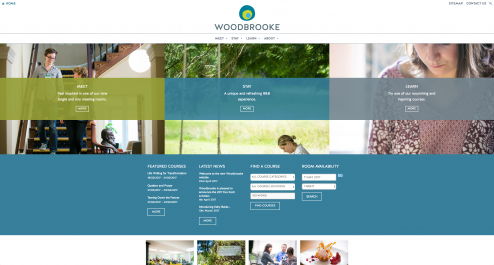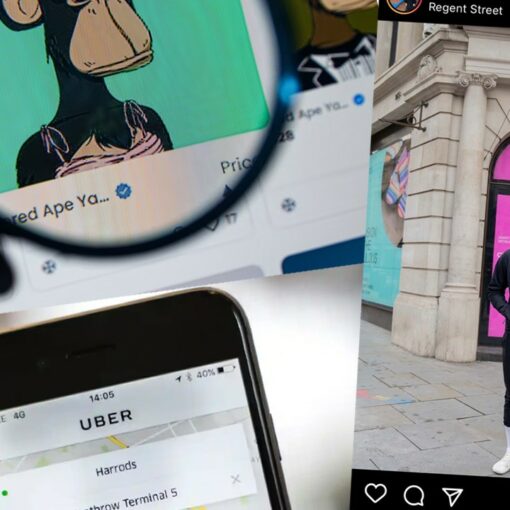Rebranding the organisation you work for is probably one of the biggest projects a marketing professional can do in their career. For most marketing professionals this will be the first time they have been involved in such a project. In this post I am going to explore the process I undertook at Woodbrooke to hire a marketing agency for a rebranding and new website project.
Understand why you are starting this project and what success looks like
This might sound like an obvious point to make, but before you start , think about the project holistically. Have a good understanding of your project, how you would like it to be run and what the ultimate goal is. Entering a project without a definite end goal can be a sign of ultimate failure. It won’t help you hire a marketing agency any easier.
Build a solid team for managing the process (This should include key internal stakeholders)
A solid and experienced management team can help to ensure your project runs on time and on budget. It is important to consider what roles you would like members of your management team to take. These roles will vary from organisation to organisation and maybe one person fits into one or more hats. The size of your management team will also vary from organisation to organisation, for Woodbrooke, my team included three members of the senior management team. There is certainly a fine line between not having enough help and feeling isolated, and having too much input and creating a project by committee. You might find some of the character types below as a good starting point for building your management team.
Character types:
- Senior Leader – It is good practice to have a senior manager or CEO (director) figure on board. Change has to filter down from the top and having key stakeholders driving that change will help all stakeholders to see the benefit of your project. It is worth considering what skills and experiences a senior manager or CEO (director) might bring from previous jobs. At Woodbrooke, the director provided technical expertise with a longer established career in software engineering in telecommunications.
- The Wildcard – You might want to consider that ‘wildcard’ type figure who you would expect to ask those ‘off-the-wall’ questions, and disrupt thinking in a constructive way. Be careful though, pick someone who you know will be a good team player and who is 100% on board with the project.
A solid and experienced management team can help to ensure your project runs on time and on budget.
- The Thinker – Never underestimate the power of a thinker in helping to guide a decision. Those, sometimes painfully slow and astonishing minutes, hours or days waiting for a decision are not intended to annoy, but allow time for decisions to sink in and settle.
- Millennial – Having someone in your team who is ‘on-trend’ will help to future proof your project, saving the embarrassment of launching a new logo or brand which although new, is already outdated. For instance many organisations who have refreshed their brands are going for flatter more simplistic designs.
 The new Woodbrooke website
The new Woodbrooke websiteHave a well planned and well thought out brief
This might be one of those ‘isn’t it obvious?’ points. A well thought out brief will not only help you to clarify your wants and needs, but it will help those agencies prepare an ‘answer’ to your ‘question’. But where should you start? Think about including these 6 headings:
Context
You should consider outlining what it is your organisation does currently, what your business aims and objectives are, and where you want to be in the next 10 years. This part of your proposal should ideally be less than 1 page long.
Project Objectives
Outline your top line objectives here. For Woodbrooke, our two objectives we very simple.
1. Rebrand Woodbrooke, to consider how the brand can represent our history but also be modern and forward thinking.
2. Redesign the Woodbrooke website, designed for the customer journey, considering the three business streams.
Try not to go into specifics here, if you objective is to just have your website refreshed, ask for it. This is where you tell the agency what success looks like.
Target Audience
You should consider outlining who your target audience is. This can include some data on who currently interacts with your brand/website and if you are looking to re-position your brand, who you want your target audience to be. Here are some examples of what you might want to talk about:
- Age.
- Gender.
- Location.
- Religion.
- Race.
- Interests.
- Buying behaviors.
Woodbrooke’s target audiences can be quite easily defined for those in our different business areas – Learning, Conferences & Accommodation. Which become Woodbrooke’s taglines and main website sections – LEARN | MEET | STAY
You might want to consider including a list of competitor websites in this section also. Be brave and include websites that you think would be beyond your budget or are outside of your organisations comfort zone.
Key Insights
Bullets points are king here. Use this as a place to list your specific needs. If you want a live chat feature, then say so. If your website needs to have an commence function to it then if you haven’t already mentioned it, make sure you do here.
Cost and Timescales
It is important to be upfront and let a prospective agency know what your budget is and when you expect the project to be delivered by. If you are not upfront, you will more than likely be wasting an agencies time and your time.
If you’re budget is fairly opened ended, or you are not sure what cost to expect for the needs of your website, set a price range for an agency to pitch in-between.
Give as much detail as you can about timescales. If you need parts of your project delivered at different times, say so. More than likely an agency will need to propose a different timescale depending on how they work. It is important to have a 1-2 month contingency in place, should any problems arise. Let your agency know about this contingency, so they can also plan ahead.
Submissions
Think about the things you want to see in a proposal, and write them into your proposal ‘must haves’. This is an easy way to help with the shortlisting process. Have they submitted the required materials.
The following worked for me and you might like to consider it for your proposal:
- Ask for a portfolio of relevant work. (In my case I asked for at least one example of project where the brand was changed and new website created)
- If budget is important to of you ask for a fixed price quotation for carrying out the work plus day rates for any additional work requested. For websites, you will want to ask them to quote for the cost of hosting and security, these can vary from £400 year to £2,000 a year.
- Get details on the availability of the agency between the given dates. Do their holidays or other projects fit in with your timelines.
- Ask for a proposed timeline and working methodology.
- Just like when you apply for a job, you will want contact details for 2 references from the last 2 years of relevant work.
How are you going to get proposals?
I would recommend the following ways of getting proposals:
- Look for websites that you like and contact the designer. You will usually be able to find the designer of the website in the footer.
- Take recommendations. Ask your friends, colleagues and other professional for recommendations, this is your chance to ask questions and find out more. But remember to do your research, check out the agency first, do they meet your initial requirements?
- Open it out to tender. Use your organisations networks and your own professional network to promote your project. Remember to set a deadline which allows enough time for prospective bidders to digest your project and come up with a well thought out proposal.
Submission Scoring for shortlisting
This is where your team comes in. Think about a two stage process.
- Send round proposals, with a scoring sheet in good time and to give your team the chance to fully reflect on each application form. This gives each member of the team an equal opportunity to respond to each proposal personally.
- Come together as a team and make an informed and collaborative decision. Set aside a morning or an afternoon to work through your shortlist. You may want to think about having access to a whiteboard or paper to note down any joined up thoughts. Allow some time to take a tea break halfway through. Give time for informal and personal reflection.
Scoring can be done in a number of ways, you may want to think about having a number of questions or considerations which your team are able to comment on. You may want to use a scoring system on these points and use the total as a quick way to reject one or two proposals.
Don’t make it too complicated though. You scoring method could look like this:
Scoring table
| Scoring | Points |
| Did not meet the criteria | 0 |
| Met the criteria | 1 |
| Exceeded the criteria | 2 |
You might want to think about asking yourself some or all of these questions against each proposal:
- Did they meet the specifics in the brief?
- Are they good value for money?
- Do they have the technical expertise to carry out the project?
- Do they have enough relevant experience for a project of your size?
It is always good practice to keep a record of how you shortlisted your applications. So make sure one person is responsible for collecting the scoring sheets and someone is able to take note of any changes in decisions against these scoring sheets. It is possible that an agency will have put a few hours into their proposal and might like some feedback as to why they were not successful.
THE PITCH
So you have shortlisted your proposals down to three or four agencies which best fit your organisational needs. You will then want to ask them to formally pitch to you. Just like a job interview, this is where you really want to test your candidates and ask some challenging questions. At Woodbrooke, we asked our candidates to pitch based on the following two points:
- We want you to show us your favourite project which has included rebranding and website development. You should think about including the steps you took, what you found difficult and what you learnt from the process. (Max 15 mins)
- We want you to show us a working example of a website(s) which you believe would stylistically and functionally best suite Woodbrooke’s requirements. This does not have to be a website you have built. (Max 7 mins)
Set aside some time for questions, which like shortlisting you can use to make against your two points. - Time for additional questions (max 7 mins)
Follow me on LinkedIn, Twitter, Instagram and TikTok.
Check out my marketing blog for tips, tricks and marketing ramblings.





